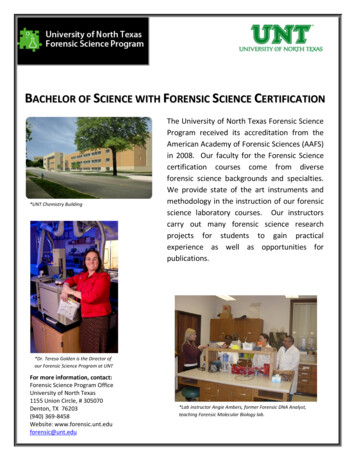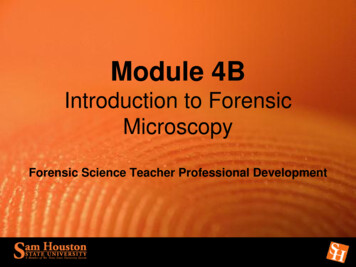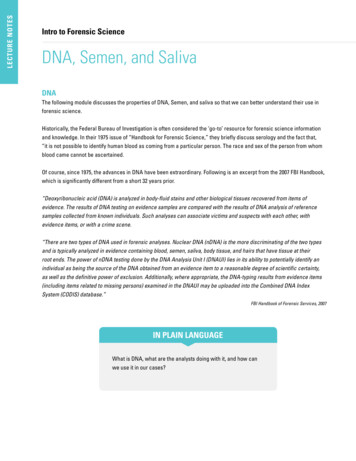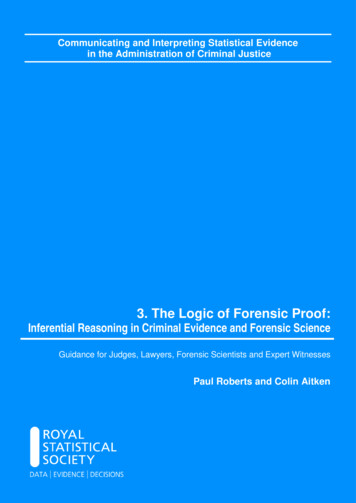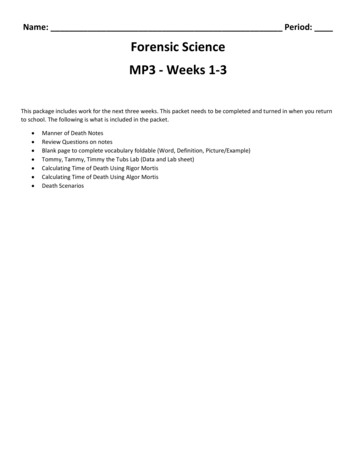
Transcription
Name: Period:Forensic ScienceMP3 - Weeks 1-3This package includes work for the next three weeks. This packet needs to be completed and turned in when you returnto school. The following is what is included in the packet. Manner of Death NotesReview Questions on notesBlank page to complete vocabulary foldable (Word, Definition, Picture/Example)Tommy, Tammy, Timmy the Tubs Lab (Data and Lab sheet)Calculating Time of Death Using Rigor MortisCalculating Time of Death Using Algor MortisDeath Scenarios
3/23/2020Chapter 12IntroductionVocabularyooo1Forensic Science: Fundamentals & Investigations, 2eChapter 12All rights ReservedCengage/NGL/South-Western 201612Forensic Science: Fundamentals & Investigations, 2eChapter 12All rights ReservedCengage/NGL/South-Western 20162Cause and Mechanismof DeathManner of DeathoOfficial terms for the manner of deathinclude: 33Death of individual body cells is a slowprocess that does not occur at the exactmoment the heart or brain stops.A single definition of death is somethingexperts still debate.Establishing a postmortem interval (PMI),which is the time between death and bodydiscovery, has great forensic importance.oNatural deathAccidental deathSuicidal deathHomicidal deathUndeterminedForensic Science: Fundamentals & Investigations, 2eChapter 12oAll rights ReservedCengage/NGL/South-Western 201644The cause of death is thereason someone dies.The mechanism of deathdescribes the specificchange in the body thatbrought about thecessation of life.Forensic Science: Fundamentals & Investigations, 2eChapter 12All rights ReservedCengage/NGL/South-Western 2016
3/23/2020Body Changes after DeathoDeath is a sequence of events that affectsome cells sooner than others. 5Forensic Science: Fundamentals & Investigations, 2eChapter 12All rights ReservedCengage/NGL/South-Western 201656Forensic Science: Fundamentals & Investigations, 2eChapter 12All rights ReservedCengage/NGL/South-Western 20166Algor Mortiso 7Livor MortisAlgor mortis PMI estimates can be accuratefor deaths that occurred within the past 24hours if the corpse has not been subject tounusual heat-loss conditions. 7Stage 1: StoppageStage 2: Autolysis, or Cell Self-DestructionooLividity first becomes noticeable about 2 hoursafter death.The discoloration becomes permanent after 8hours.For the first 12 hours after death, the body cools ata rate of .78 C (1.4 F) per hour.After the first 12 hours, the body cools about .39 C(.7 F) per hour until the body reaches the sametemperature as the surroundings.These rates are an estimate and may vary.Forensic Science: Fundamentals & Investigations, 2eChapter 12All rights ReservedCengage/NGL/South-Western 201688Forensic Science: Fundamentals & Investigations, 2eChapter 12All rights ReservedCengage/NGL/South-Western 2016
3/23/2020Rigor Mortisooo9Rigor Mortis (continued)Rigor mortis usuallybecomes apparentwithin 2 hours afterdeath.The stiffness progressesfrom smaller musclegroups to larger musclegroups.After 12 hours, the bodyis at its most rigid state.Forensic Science: Fundamentals & Investigations, 2eChapter 12All rights ReservedCengage/NGL/South-Western 2016910Forensic Science: Fundamentals & Investigations, 2eChapter 12All rights ReservedCengage/NGL/South-Western 201610Rigor Mortis (continued)AutopsyoooAn autopsy is a medical examination todetermine the cause and manner of death.Clinical autopsies are done for medicalresearch study purposes and foul play is notconsidered.Forensic autopsies are performed when foulplay is suspected. 1111Forensic Science: Fundamentals & Investigations, 2eChapter 12All rights ReservedCengage/NGL/South-Western 20161212External examinationInternal examinationForensic Science: Fundamentals & Investigations, 2eChapter 12All rights ReservedCengage/NGL/South-Western 2016
3/23/2020Stomach and IntestinalContentsooo13Stages of DecompositionWithin 2 to 6 hours,the stomach emptiesits contents into thesmall intestines.Within 12 more hours,the food leaves thesmall intestine.Within about 24hours, the wastes arereleased through therectum.Forensic Science: Fundamentals & Investigations, 2eChapter 12All rights ReservedCengage/NGL/South-Western 20161314Forensic Science: Fundamentals & Investigations, 2eChapter 1214Stages of DecompositionSummary(continued)o“Rule of Thumb" PMIestimate 1515All rights ReservedCengage/NGL/South-Western 2016oBody feels warm and isflaccid (dead less than 3hours)Body feels warm and is stiff(dead 3-8 hours)Body feels cold and is stiff(dead 8-36 hours)Body feels cold and isflaccid (dead more than 36hours)Forensic Science: Fundamentals & Investigations, 2eChapter 12oAll rights ReservedCengage/NGL/South-Western 20161616Death is a process that involves both individualcell death and organism death. The medicaland legal communities have been unable toagree upon a precise definition of death.When a person dies, it is important to establishthe manner, cause, and mechanism of death.An exact time since death, or postmorteminterval (PMI), is sometimes difficult toestimate.Forensic Science: Fundamentals & Investigations, 2eChapter 12All rights ReservedCengage/NGL/South-Western 2016
3/23/2020Summary (continued)oo1717Summary (continued)Shortly after death, the body undergoes algor, rigor,and livor mortis. The rate at which they occur isaffected by environmental and physiological factorssuch as ambient temperature, clothing, body mass,age, state of disease, and burial site (if any) of thebody.Physical and chemical changes that occur after death,such as bloating, skin marbling, and adipocereformation, are caused by decomposition. The processbegins with autolysis of cells, is followed byputrefaction, and proceeds to the total degradation ofsoft tissues.Forensic Science: Fundamentals & Investigations, 2eChapter 12All rights ReservedCengage/NGL/South-Western 2016oo1818Autopsies are typically performed by medical examiners.During an autopsy, the medical examiner performsexternal and internal examinations, images variouspertinent body regions, removes and weighs organs,and takes tissue and fluid samples from organs, oftenincluding the eye, stomach, liver, and brain.To estimate a postmortem interval, evidence is compiledfrom the body, the environment, the autopsy findings,and the person’s social contacts, if necessary. A PMI isnever precise because of the many environmentalvariables and other factors that influence what happensto a body after death.Forensic Science: Fundamentals & Investigations, 2eChapter 12All rights ReservedCengage/NGL/South-Western 2016
NotesQuestions:1. What does PMI measure?2. How many official terms of manner of death are there? And explain one of them.3. Lividity can become noticeable about 2 hours after death this is because blood starts to pool what force causesthe blood to pool at the bottom of the body?4. There is a general guideline for the time after death and the state at which a body is in rigor mortis what threefactors can influence this timeline?5. Give an estimate for the time of the death for the following three victimsa. a person is found dead and is still warm however you cannot move his armsb. a female is found dead feels cold and the body can be moved easilyc. a man is found dead warm and while transporting him his arm falls off the gurney and swings back andforth
Timmy, Tammy, Tommy the Tubs at home Directions:During this lab we are trying to see how a body loses temperature overtime. During this lab a tub was placed in a coldenvironment and a separate tub was placed out in the open air the following data table shows the three differenttemperatures per hour for each of the different places they have been labeled accordingly. Complete the worksheet onthe next page. Steps one through four have been completed for you already, use the following data table to completethe rest of the worksheet.For step #7 you will have to graph Tammy Tommy and a real corpse use slide number six from the power points to graphthe temperature for a real corpse.
Name: Date: Period:Tommy, Tammy, and Timmy the TubsProcedure:1. Fill a tub with approximately 66 liters of hot water, adjusting the temperature to about 37 C (98.6 F).2. Connect two temperature probes to a computer or TI-83 calculator to record temperature readingsover an extended period. One probe should record the ambient air temperature. The second probeshould be submerged in the tub to record the “body temperature.”3. Set the probe to measure temperature at one-hour intervals for a 24-hour period.4. Record tub temperatures on the data table.5. From the probe ware data or your data table, determine the average air temperature over the 24- hourperiod.Average air temperature CTime (h)Tammy( C)Ambient( C)Tommy( C)Time (h)013114215316417518619720821922102311Averageloss perhour12Tammy ( C)Ambient ( C)Tommy ( C)7. Prepare a best-fit graph of Tommy’s and Tammy’s and real human corpses (use 3 different colors) heatloss over a 24-hour period.Include in your graph:a. Title of graphb. Labeled x and y axisc. Draw the best-fit line (This line is approximated. It will be a straight line that will pass throughsome of the points but not necessarily all of them. There will be some points on either sideof the line and not on the line.)
Tommy –Tammy –Real Human –Questions:1. How do Tommy and Tammy the Tub’s temperature losses over the first 12 hours compare with that of areal human corpse? Explain your answer. Include data from your graph or data table to support youranswer.2. How does Tommy and Tammy’s temperature losses over the next 12 hours (hours 13 to 24) compare withthe expected heat loss of a real human corpse? Explain your answer. Include data from your graph ordata table to support your answer.3. Explain some of the limitations of using Tommy and Tammy the Tub as an appropriate model for ahuman body.4. How could you design a more realistic model of a human corpse to be used in this experiment?5. Did the ambient temperature change over the 24-hour period? If the ambient temperature did change,describe its possible impact on the loss of temperature noted on Tommy the Tub.6. List some variables affecting the rate of heat loss from a human corpse.
Name: Date: Period:CALCULATING TIME OF DEATH USING RIGOR MORTISBackground:In old detective movies, a dead body was often referred to as a “stiff.” The term refers to the onset of rigor mortis thatfollows soon after death. In this activity, you will estimate the approximate time of death by analyzing the degree of rigorof the deceased body. Refer to the powerpoint.Estimate the PMI for the following situations. Explain each of your answers:1. A body was found with no evidence of rigor.2. A body was found exhibiting rigor throughout the entire body.3. A body was found exhibiting rigor in the chest, arms, face, and neck.4. A body was discovered with rigor present in the legs, but no rigor in the upper torso.5. A body was discovered with most muscles relaxed, except for the face.6. A body was discovered in the weight room of a gym. A man had been doing “biceps curls” with heavy weights. The only placerigor was present was in his arms.Estimate the PMI based on the following information:7. A frail, elderly woman’s body was found in her apartment on a hot summer’s evening. Her body exhibited advanced rigor in allplaces except her face and neck.8. A body was discovered in the woods. The man had been missing for two days. The average temperature the past 48 hours was10 C. When the body was discovered, it was at peak rigor.9. An obese man was discovered in his air-conditioned hotel room sitting in a chair in front of the television. The air conditioner wasset for 18.3 C. When the coroner arrived, the man’s body exhibited rigor in his upper body only.10. While jogging, a young woman was attacked and killed. The perpetrator hid the body in the trunk of a car and fled. When thewoman’s body was discovered, rigor was noticed in her thighs only.11. The victim’s body is completely stiff. How long has she been dead? Explain your answer.12. The body is completely stiff. How long has he been dead? Explain your answer.13. The victim was found in a snowbank alongside a road. His body is rigid. How long has he been dead? Explain your answer,remembering the cold temperature.14. The body of the runner was found in the park one early, hot summer morning. Her body shows rigor in her face, neck, arms, andtorso. How long has she been dead? Explain your answer.Over
Part 2: Calculating Post Mortem Interval (PMI) Using Algor MortisNormal Body Temp: 37 C.Body Loses: 0.78 C per hour for the first 12 hours0.39 C per hour after the first 12 hoursPart A: Determine the approx. PMI (time) using evidence from Algor mortis. Show your work!!1.Estimate the PMI is the victim’s body temperature at the crime scene was 33.1 C2.If you discovered that the body in question 1 was found in an air-conditioned room,would that variable increase or decrease your estimated PMI?What would the new PMI be?1.Approximately how long has the victim been dead if his body temp. was 25.9 C?2.What is the approximate PMI if the body temperature was:1. 15.6 C2.29.4 CPart B: If based your PMI estimate of 10 hours solely on temperature decrease, would youreduce or increase your 10 hour estimate if the body had been?:1.Naked2.Exposed to windy conditions3.Suffering from illness prior to death4.Submerged in a lake
Forensics Activity: Death ScenariosObjectives:1. Determine cause of death, mechanism of death, and manner of death fromdescriptions of events.2. Create a scenario to illustrate cause of death, mechanism of death, and manner of death.Procedure: Read the following scenarios and determine the cause of death, mechanism of death, and themanner of death in each. Place your answers to the questions on loose-leaf paperBackground: When a death occurs, a physician or medical examiner must fill out a death certificate.In order to properly complete this document, they must determine three things: the cause, themechanism, and the manner of death. There is often confusion about which is which. The cause ofdeath is the disease or injury that produces the physiological disruption inside the body resulting indeath, for example, a gunshot wound to the chest. The mechanism of death is the physiologicalderangement that results in the death. An example of a mechanism of death due to the gunshotwound described above is exsanguination (extreme blood loss). Last but not least, the manner ofdeath is how the death came about.Manner of death can be classified in six ways:1) Natural 2) Accident 3) Suicide 4) Homicide 5) Undetermined 6) PendingScenario 1An elderly woman in her mid-70’s was walking to the local drugstore. On her way, a man shoved heras he walked by and stole her purse. She was not injured in the altercation but was clearly shakenup. About 10 minutes later, she began to experience shortness of breath and chest pain. She wastaken to the emergency room. While she was being examined, she developed an irregular heartbeatand died.Questions:1. What is the cause of death?2. What is the mechanism of death?3. What is the manner of death?4. Should anyone in the scenario be charged with murder? Why or why not?
Scenario 2Laura was babysitting for her neighbor’s two-year-old and had just put little Justin down for a nap. Asshe was sitting n the living room texting her friends about the movie they had planned to see later inthe evening, she heard the sound of braking glass. Laura grabbed a baseball bat that was proppedup in the corner and went to investigate. As she rounded the corner to the kitchen, she noticedbroken glass from the door. When Laura turned around, she saw the intruder coming toward her,wielding a very large knife. To her surprise, she raised the bat and crushed his skull. Laura called911, and police and paramedics responded within minutes. Unfortunately for the intruder, it wasn’tfast enough and he died before they arrived.Questions:1. What is the cause of death?2. What is the mechanism of death?3. What is the manner of death?4. Should anyone in the scenario be charged with murder? Why or why not?Scenario 3Devin (age 17) and Carlos (age 16) were known around the neighborhood as “future Felons” becauseof their frequent run-ins with the law. One afternoon, they decided they wanted to run the local drugdealer out of business and take over his clientele. In order to accomplish this, the boys neededmoney. So they came up with a plan. The next evening, Devin and Carlos put on dark clothing andski masks and broke into the corner drugstore about an hour after closing. Neither of them wasaware of a night watchman, so when Mr. Hernandez surprised them, Devin, who was carrying a gun,accidently shot and killed Mr. Hernandez. Frightened, both boys fled the scene. When thepharmacist arrived the next morning, she found Mr. Hernandez lying in a pool of blood in front of theprescription counter.Questions:1. What is the cause of death?2. What is the mechanism of death?3. What is the manner of death?4. Should anyone in the scenario be charged with murder? Why or why not?
Scenario 4: Create a scenario.
Name: _ Period: _ Forensic Science MP3 - Weeks 1-3 This package includes work for the next three weeks.




